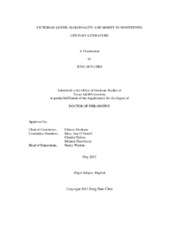| dc.description.abstract | This dissertation examines how Victorians used the word “queer” as associated with senses of “counterfeit” and “eccentricity” in selected Victorian novels. The word was popularly used, by Victorian writers of both genders and in various and diverse circumstances, to mean the unfamiliar, the unconventional, the incomprehensible, and the non-normal. Unlike the contemporary uses of the word, which are oriented toward a relatively particular meaning, the non-normal sexual, Victorian uses of the word had been fluid, unstable, and indeterminate, yet referring to or associating with the non-normal aspects in things and people. Knowing how the Victorians used the word helps us to understand that a concept of marginality can be extended to the extent of tolerating Otherness in marginalized positions and minority identities.
Victorian novels including Mary Elizabeth Braddon’s Aurora Floyd (1863), Wilkie Collins’s Hide and Seek (1854), and Charlotte Brontë’s Jane Eyre (1847) demonstrate how the word “queer” is indeterminately used and also represent how queer marginality is appreciated or rejected, and tolerated or discriminated against. As queerness is defined as the status of counterfeitabilty, a counterpart of authenticity, queer subjects are described to provoke a feeling of repulsion and tend to be criminalized or pathologized.
On the other hand, as queerness is defined as the status of eccentricity, queer subjects are sympathized and defended in the narrative. Manifestations of eccentricities in queer subjects are occasionally reprimanded, but admired for queer subjects’ uncommon or distinguished individuality. Victorian novels demonstrate that queer marginality can be employed as a self-fashioning identity or social status for any non-normal individual to deal with social pressure of conformity. | en |


